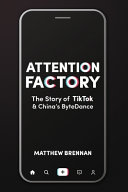

The book introduces the concept of the attention economy, where attention is treated as a scarce resource. In today's digital landscape, platforms compete for users' attention, making it a valuable commodity. The author discusses how social media companies have designed their products to capture and retain user attention, often leading to addictive behaviors. This idea emphasizes the need for individuals and businesses to understand the dynamics of attention in order to navigate the digital world effectively.
Continue readingAlgorithms play a crucial role in shaping user experiences on social media platforms. The book delves into how algorithms prioritize content based on user engagement, leading to filter bubbles and echo chambers. This idea highlights the importance of transparency in algorithmic decision-making and the potential consequences of algorithm-driven content curation on societal discourse and individual perspectives.
Continue readingAttention Factory explores various strategies employed by social media platforms to enhance user engagement. These strategies include gamification, notifications, and personalized content feeds. The author illustrates how these tactics are designed to keep users coming back, often at the expense of their well-being. This idea underscores the ethical considerations of user engagement practices and the responsibility of tech companies to prioritize user welfare.
Continue readingThe monetization of attention is a central theme in the book. It discusses how social media platforms generate revenue through advertising and how this model incentivizes the creation of clickbait and sensational content. The author argues that the pursuit of profit can lead to a decline in content quality and an increase in misinformation. This idea encourages readers to critically evaluate the content they consume and understand the economic forces at play in the digital landscape.
Continue readingThe book addresses the impact of social media on mental health, particularly regarding anxiety, depression, and self-esteem. It discusses how the constant comparison with others and the pressure to maintain an online persona can affect individuals' well-being. This idea serves as a call to action for both users and platform creators to consider the psychological implications of their engagement with social media.
Continue readingAttention Factory speculates on the future of social media and the potential shifts in user behavior and platform design. The author suggests that as awareness of the attention economy grows, users may demand more ethical practices and transparency from tech companies. This idea encourages readers to think critically about the evolution of social media and the role they play in shaping its future.
Continue readingThe final idea revolves around the empowerment of users through awareness of the attention economy. The book advocates for informed consumption of digital content and encourages readers to take control of their online experiences. By understanding the mechanisms behind attention-driven platforms, individuals can make more conscious choices about their engagement with technology. This idea promotes digital literacy as a crucial skill in the modern world.
Continue reading